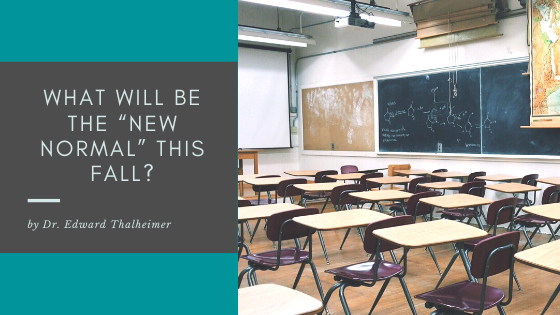As the school year winds down and the summer begins, many parents are looking ahead to the fall with trepidation and uncertainty. What will schools look like in the fall? Will schools be able to enforce social distancing guidelines? So many questions, and quite honestly, right now there aren’t any definite answers.
Currently, most school districts and state education departments are looking at several options, but none of those options would be considered “normal” by pre-pandemic standards. What is clear is that there will most certainly be a period of adjustment.
Several scenarios have proposed thus far regarding reopening schools. Recently, New America, a Washington D.C. think tank, published a guideline for what schools might look like this fall. Within that guide, the authors laid out four approaches. All four approaches assume that distance learning in some form or another will be part of the equation.
The following options are what the New America authors have suggested:
- Schools will go entirely remote. All programs, instruction, and support services will be done through distance learning.
- Schools will return to physical classrooms, but will have done the necessary preparation and planning to quickly transition to distance learning in the event of an outbreak.
- Schools will start out the academic year with online coursework and monitor the local health guidelines to determine when it is safe to return to classrooms.
- Schools will offer blending learning using staggered schedules that allow for a mix of online and in-person instruction on a consistent schedule throughout the year.
Other public health experts and educators have echoed similar options to these. At this point, most decision-makers are in agreement that there is no ideal option. There are merely varying levels of risk and dependent on the level of spread within the community the school serves.
What’s important is to keep the best interests of our children in mind. Students will face challenges in the coming school year and we must help them prepare to overcome those challenges to the best of our ability.
Children are resilient and we can continue to foster that skill throughout the summer months. The American Psychological Association provides tips for building resilience in our children such as helping them to build connections with others’ and develop empathy, taking the time to help others, keeping things in perspective, and fostering a positive self-view. If you’d like to read more about fostering resilience, you can check out the APA’s Resilience Guide for Parents & Teachers.
While we may be uncertain about how things will look this fall, we must do our best to forge ahead and be flexible enough to adjust when circumstances call for it.
———–
Parents are left trying to balance family obligations, work, and now homeschooling their children. If you have found yourself struggling to help your child with school work, you’re not alone. Many parents are struggling with this exact same issue. It takes time to find the resources and keep children on track and focused on their learning when you’re trying to work from home yourself. It’s a lot, and it can be overwhelming.
For our part, we here at The Tutoring Center® are continuing to provide one-to-one instruction combined with The Rotational Approach to Learning® to prevent children from slipping through the cracks academically. Our programs help children achieve long-term success, build concentration and focus, and, with our outstanding instructors, find the love of learning. Don’t let your child fall behind. Give them the opportunity to grow academically this summer. If you’re interested in learning more, visit our website at TutoringCenter.com.
